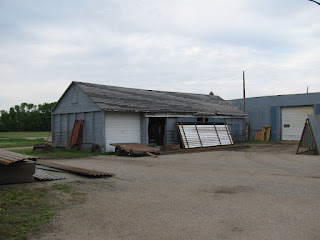{I have updated this post and corrected errors as best I could. New post can be found here: http://jjwtrains.blogspot.com/2012/09/a-good-place-to-model-redone.html
A person from the area has brought to my attention a few minor errors in this post. Errors are corrected by red lettering. While visiting Minnesota, I came across the small town of Villard, MN. It has a station, and a large grain complex that was served by the railroad,Soo Line Burlington Northern to be exact. Anyway, here is a listing of buildings that were served by the railroad in town:
The trail could possibly be on a second set of tracks, making a runaround. From photos, I now know that the station was actually between the runaround tracks. Therefore, a second set of tracks would have gone behind the depot, and past the elevator. The tracks continue in the distance to go between Lake Amelia and Lake Villard on a man-made land bridge.
Here is the old feed building, or what's left of it. This would have been a truck transfer point, as there are doors on either side (one side for trains, the other for trucks).
The elevator was still running in the 60s, although the tracks may have been ripped up. I say that because there is a scale in place for trucks, and a 1960s-70s truck is in the weeds bearing the name of the Elevator Co-op.
Prior to this Co-op, the elevator was owned by Great Western Elevator Co.
here is the second grain storage building. If this were supplied by rail and truck, it is likely that the trains had a platform leading to the building as the doors on the other side are too low.
Here is the overall complex
A person from the area has brought to my attention a few minor errors in this post. Errors are corrected by red lettering. While visiting Minnesota, I came across the small town of Villard, MN. It has a station, and a large grain complex that was served by the railroad,
- Station depot/ both passenger and freight.
- Grain elevator/ loading and unloading spots, plus a car spot by the main office.
- Grain storage building 1/ 3 car spots
- Grain storage building 2/ 4-5 car spots
And here are some photos to give you a general idea of what the town looks like:
 |
| Here is the front of the Depot, with both the freight and the passenger areas, I am standing on a trail next to the 100 remaining fee of track still in town. |
 |
| In the fore ground, you can see the track. The track would probably have continued to the left of the metal grain silos. A spur track would have gone between the silos and the elevator. |
Here is the old feed building, or what's left of it. This would have been a truck transfer point, as there are doors on either side (one side for trains, the other for trucks).
The elevator was still running in the 60s, although the tracks may have been ripped up. I say that because there is a scale in place for trucks, and a 1960s-70s truck is in the weeds bearing the name of the Elevator Co-op.
Prior to this Co-op, the elevator was owned by Great Western Elevator Co.
here is the second grain storage building. If this were supplied by rail and truck, it is likely that the trains had a platform leading to the building as the doors on the other side are too low.
Here is the overall complex
And there is where the trains would go to load/unload cars.













